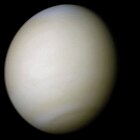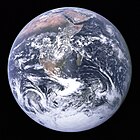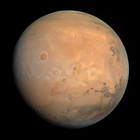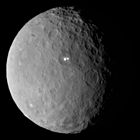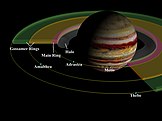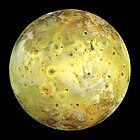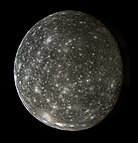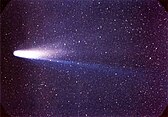Usage
- Add a new Selected article to the next available subpage using "Create..." link below.
- Update
|max=to new total for its {{ Random portal component}} on the main page.
Selected articles list
Portal:Solar System/Selected article/1
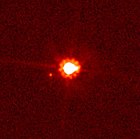
Eris has one large known moon, Dysnomia. In February 2016, Eris's distance from the Sun was 96.3 AU (14.41 billion km; 8.95 billion mi), more than three times that of Neptune or Pluto. With the exception of long-period comets, Eris and Dysnomia were the most distant known natural objects in the Solar System until the discovery of 2018 AG37 and 2018 VG18 in 2018. ( Full article...)
Portal:Solar System/Selected article/2
The Sun is the star at the center of the Solar System. It is a massive, hot ball of plasma, inflated and heated by energy produced by nuclear fusion reactions at its core. Part of this energy is emitted from its surface as visible light, ultraviolet, and infrared radiation, providing most of the energy for life on Earth. The Sun has been an object of veneration in many cultures. It has been a central subject for astronomical research since antiquity.The Sun orbits the Galactic Center at a distance of 24,000 to 28,000 light-years. From Earth, it is on average 1 AU (1.496×108 km) or about 8 light-minutes away. Its diameter is about 1,391,400 km (864,600 mi; 4.64 LS), 109 times that of Earth. Its mass is about 330,000 times that of Earth, making up about 99.86% of the total mass of the Solar System. Roughly three-quarters of the Sun's mass consists of hydrogen (~73%); the rest is mostly helium (~25%), with much smaller quantities of heavier elements, including oxygen, carbon, neon, and iron. ( Full article...)
Portal:Solar System/Selected article/3
Mercury is the first planet from the Sun and the smallest in the Solar System. In English, it is named after the Roman god Mercurius ( Mercury), god of commerce and communication, and the messenger of the gods. Mercury is classified as a terrestrial planet, with roughly the same surface gravity as Mars. The surface of Mercury is heavily cratered, as a result of countless impact events that have accumulated over billions of years. Its largest crater, Caloris Planitia, has a diameter of 1,550 km (960 mi) and one-third the diameter of the planet (4,880 km or 3,030 mi). Similarly to the Earth's Moon, Mercury's surface displays an expansive rupes system generated from thrust faults and bright ray systems formed by impact event remnants.Mercury's sidereal year (88.0 Earth days) and sidereal day (58.65 Earth days) are in a 3:2 ratio. This relationship is called spin–orbit resonance, and sidereal here means "relative to the stars". Consequently, one solar day (sunrise to sunrise) on Mercury lasts for around 176 Earth days: twice the planet's sidereal year. This means that one side of Mercury will remain in sunlight for one Mercurian year of 88 Earth days; while during the next orbit, that side will be in darkness all the time until the next sunrise after another 88 Earth days.
Combined with its high orbital eccentricity, the planet's surface has widely varying sunlight intensity and temperature, with the equatorial regions ranging from −170 °C (−270 °F) at night to 420 °C (790 °F) during sunlight. Due to the very small axial tilt, the planet's poles are permanently shadowed. This strongly suggests that water ice could be present in the craters. Above the planet's surface is an extremely tenuous exosphere and a faint magnetic field that is strong enough to deflect solar winds. Mercury has no natural satellite. ( Full article...)
Portal:Solar System/Selected article/4
Venus is the second planet from the Sun. It is a terrestrial planet and is the closest in mass and size to its orbital neighbour Earth. Venus is notable for having the densest atmosphere of the terrestrial planets, composed mostly of carbon dioxide with a thick, global sulfuric acid cloud cover. At the surface it has a mean temperature of 737 K (464 °C; 867 °F) and a pressure of 92 times that of Earth's at sea level. These conditions are extreme enough to compress carbon dioxide into a supercritical state close to Venus's surface.Internally, Venus has a core, mantle, and crust. Venus lacks an internal dynamo, and its weak induced magnetosphere is instead caused by atmospheric interactions with the solar wind. Internal heat escapes through active volcanism, resulting in resurfacing instead of plate tectonics. Venus is one of two planets in the Solar System that have no moons. Conditions perhaps favourable for life on Venus have been identified at its cloud layers. Venus may have had liquid surface water early in its history with a habitable environment, before a runaway greenhouse effect evaporated any water and turned Venus into its present state. ( Full article...)
Portal:Solar System/Selected article/5
Earth is the third planet from the Sun and the only astronomical object known to harbor life. This is enabled by Earth being a water world, the only one in the Solar System sustaining liquid surface water. Almost all of Earth's water is contained in its global ocean, covering 70.8% of Earth's crust. The remaining 29.2% of Earth's crust is land, most of which is located in the form of continental landmasses within Earth's land hemisphere. Most of Earth's land is somewhat humid and covered by vegetation, while large sheets of ice at Earth's polar deserts retain more water than Earth's groundwater, lakes, rivers and atmospheric water combined. Earth's crust consists of slowly moving tectonic plates, which interact to produce mountain ranges, volcanoes, and earthquakes. Earth has a liquid outer core that generates a magnetosphere capable of deflecting most of the destructive solar winds and cosmic radiation.Earth has a dynamic atmosphere, which sustains Earth's surface conditions and protects it from most meteoroids and UV-light at entry. It has a composition of primarily nitrogen and oxygen. Water vapor is widely present in the atmosphere, forming clouds that cover most of the planet. The water vapor acts as a greenhouse gas and, together with other greenhouse gases in the atmosphere, particularly carbon dioxide (CO2), creates the conditions for both liquid surface water and water vapor to persist via the capturing of energy from the Sun's light. This process maintains the current average surface temperature of 14.76 °C (58.57 °F), at which water is liquid under atmospheric pressure. Differences in the amount of captured energy between geographic regions (as with the equatorial region receiving more sunlight than the polar regions) drive atmospheric and ocean currents, producing a global climate system with different climate regions, and a range of weather phenomena such as precipitation, allowing components such as nitrogen to cycle. ( Full article...)
Portal:Solar System/Selected article/6
The Moon is Earth's only natural satellite. It orbits at an average distance of 384,400 km (238,900 mi), about 30 times the diameter of Earth. Over time Earth's gravity has caused tidal locking, causing the same side of the Moon to always face Earth. Because of this, the lunar day and the lunar month are the same length, at 29.5 Earth days. The Moon's gravitational pull – and to a lesser extent, the Sun's – are the main drivers of Earth's tides.In geophysical terms the Moon is a planetary-mass object or satellite planet. Its mass is 1.2% that of the Earth, and its diameter is 3,474 km (2,159 mi), roughly one-quarter of Earth's (about as wide as Australia.) Within the Solar System, it is the largest and most massive satellite in relation to its parent planet, the fifth largest and most massive moon overall, and larger and more massive than all known dwarf planets. Its surface gravity is about one sixth of Earth's, about half of that of Mars, and the second highest among all Solar System moons, after Jupiter's moon Io. The body of the Moon is differentiated and terrestrial, with no significant hydrosphere, atmosphere, or magnetic field. It formed 4.51 billion years ago, not long after Earth's formation, out of the debris from a giant impact between Earth and a hypothesized Mars-sized body called Theia. ( Full article...)
Portal:Solar System/Selected article/7
Mars is the fourth planet from the Sun. The surface of Mars is orange-red because it is covered in iron(III) oxide dust, giving it the nickname "the Red Planet". Mars is among the brightest objects in Earth's sky and its high-contrast albedo features have made it a common subject for telescope viewing. It is classified as a terrestrial planet and is the second smallest of the Solar System's planets with a diameter of 6,779 km (4,212 mi). In terms of orbital motion, a Martian solar day ( sol) is equal to 24.5 hours and a Martian solar year is equal to 1.88 Earth years (687 Earth days). Mars has two natural satellites that are small and irregular in shape: Phobos and Deimos.The relatively flat plains in northern parts of Mars strongly contrast with the cratered terrain in southern highlands – this terrain observation is known as the Martian dichotomy. Mars hosts many enormous extinct volcanos (such as Olympus Mons, 21.9 km or 13.6 mi tall) and one of the largest canyons in the Solar System ( Valles Marineris, 4,000 km or 2,500 mi long). Geologically, the planet is fairly active with marsquakes trembling underneath the ground, dust devils sweeping across the landscape, and cirrus clouds. Carbon dioxide is substantially present in Mars's polar ice caps and thin atmosphere. During a year, there are large surface temperature swings on the surface between −78.5 °C (−109.3 °F) to 5.7 °C (42.3 °F) similar to Earth's seasons, as both planets have significant axial tilt. ( Full article...)
Portal:Solar System/Selected article/8
Ceres ( minor-planet designation: 1 Ceres) is a dwarf planet in the middle main asteroid belt between the orbits of Mars and Jupiter. It was the first known asteroid, discovered on 1 January 1801 by Giuseppe Piazzi at Palermo Astronomical Observatory in Sicily, and announced as a new planet. Ceres was later classified as an asteroid and then a dwarf planet, the only one inside Neptune's orbit.Ceres's small size means that even at its brightest, it is too dim to be seen by the naked eye, except under extremely dark skies. Its apparent magnitude ranges from 6.7 to 9.3, peaking at opposition (when it is closest to Earth) once every 15- to 16-month synodic period. As a result, its surface features are barely visible even with the most powerful telescopes, and little was known about it until the robotic NASA spacecraft Dawn approached Ceres for its orbital mission in 2015. ( Full article...)
Portal:Solar System/Selected article/9
The Oort cloud ( /ɔːrt, ʊərt/), sometimes called the Öpik–Oort cloud, is theorized to be a vast cloud of icy planetesimals surrounding the Sun at distances ranging from 2,000 to 200,000 AU (0.03 to 3.2 light-years). The concept of such a cloud was proposed in 1950 by the Dutch astronomer Jan Oort, in whose honor the idea was named. Oort proposed that the bodies in this cloud replenish and keep constant the number of long-period comets entering the inner Solar System—where they are eventually consumed and destroyed during close approaches to the Sun.The cloud is thought to comprise two regions: a disc-shaped inner Oort cloud aligned with the solar ecliptic (also called its Hills cloud) and a spherical outer Oort cloud enclosing the entire Solar System. Both regions lie well beyond the heliosphere and are in interstellar space. The innermost portion of the Oort cloud is more than a thousand times as distant from the Sun than the Kuiper belt, the scattered disc and the detached objects—three nearer reservoirs of trans-Neptunian objects. ( Full article...)
Portal:Solar System/Selected article/10
Jupiter is the fifth planet from the Sun and the largest in the Solar System. A gas giant, Jupiter's mass is more than two and a half times that of all the other planets in the Solar System combined and slightly less than one one-thousandth the mass of the Sun. Jupiter orbits the Sun at a distance of 5.20 AU (778.5 Gm) with an orbital period of 11.86 years. It is the third brightest natural object in the Earth's night sky after the Moon and Venus and has been observed since prehistoric times. Its name derives from Jupiter, the chief deity of ancient Roman religion.Jupiter was the first planet to form, and its inward migration during the primordial Solar System impacted much of the formation history of the other planets. Hydrogen constitutes 90% of Jupiter's volume, followed by helium, which forms 25% of its mass and 10% of its volume. The ongoing contraction of Jupiter's interior generates more heat than the planet receives from the Sun. Its internal structure is believed to consist of an outer mantle of fluid metallic hydrogen and a diffuse inner core of denser material. Because of its rapid rotation rate of one rotation per ten hours, Jupiter's shape is an oblate spheroid; it possesses a slight but noticeable bulge around the equator. The outer atmosphere is divided into a series of latitudinal bands, with turbulence and storms along their interacting boundaries. The most obvious result of this is the Great Red Spot, a giant storm that has been recorded since at least 1831. ( Full article...)
Portal:Solar System/Selected article/11
Uranus is the seventh planet from the Sun. It is a gaseous cyan-coloured ice giant. Most of the planet is made of water, ammonia, and methane in a supercritical phase of matter, which in astronomy is called 'ice' or volatiles. The planet's atmosphere has a complex layered cloud structure and has the lowest minimum temperature of 49 K (−224 °C; −371 °F) out of all the Solar System's planets. It has a marked axial tilt of 82.23° with a retrograde rotation period of 17 hours and 14 minutes. This means that in an 84-Earth-year orbital period around the Sun, its poles get around 42 years of continuous sunlight, followed by 42 years of continuous darkness.Uranus has the third-largest diameter and fourth-largest mass among the Solar System's planets. Based on current models, inside its volatile mantle layer is a rocky core, and surrounding it is a thick hydrogen and helium atmosphere. Trace amounts of hydrocarbons (thought to be produced via hydrolysis) and carbon monoxide along with carbon dioxide (thought to have been originated from comets) have been detected in the upper atmosphere. There are many unexplained climate phenomena in Uranus's atmosphere, such as its peak wind speed of 900 km/h (560 mph), variations in its polar cap, and its erratic cloud formation. The planet also has very low internal heat compared to other giant planets, the cause of which remains unclear. ( Full article...)
Portal:Solar System/Selected article/12
The planet Jupiter has a system of faint planetary rings. The Jovian rings were the third ring system to be discovered in the Solar System, after those of Saturn and Uranus. The main ring was discovered in 1979 by the Voyager 1 space probe and the system was more thoroughly investigated in the 1990s by the Galileo orbiter. The main ring has also been observed by the Hubble Space Telescope and from Earth for several years. Ground-based observation of the rings requires the largest available telescopes.The Jovian ring system is faint and consists mainly of dust. It has four main components: a thick inner torus of particles known as the "halo ring"; a relatively bright, exceptionally thin "main ring"; and two wide, thick and faint outer " gossamer rings", named for the moons of whose material they are composed: Amalthea and Thebe. ( Full article...)
Portal:Solar System/Selected article/13
Io (pronounced /ˈaɪoʊ/ eye'-oe, or as Greek Ῑώ) is the innermost of the four Galilean moons of Jupiter and, with a diameter of 3,642 kilometers, the fourth largest moon in the Solar System. It was discovered in 1610 by Galileo Galilei, along with the other Galilean satellites. This discovery furthered the adoption of the Copernican model of the Solar System and the development of Kepler's laws of motion. Unlike most satellites in the outer Solar System (which have a thick coating of ice), Io is primarily composed of silicate rock surrounding a molten iron or iron sulfide core. Io has one of the most geologically active surfaces in the solar system, with over 400 active volcanoes. This extreme geologic activity is the result of tidal heating from friction generated within Io's interior by Jupiter's varying pull. Several volcanoes produce plumes of sulfur and sulfur dioxide that climb as high as 500 km (310 mi). Io's surface is also dotted with more than 100 mountains that have been uplifted by extensive compression at the base of the moon's silicate crust. Some of these peaks are taller than Earth's Mount Everest. Most of Io's surface is characterized by extensive plains coated with sulfur and sulfur dioxide frost. ( Full article...)Portal:Solar System/Selected article/14
Europa is the sixth-nearest and fourth-largest natural satellite of the planet Jupiter. Europa was discovered in 1610 by Galileo Galilei (and independently by Simon Marius), and named for a mythical Phoenician noblewoman, Europa, who was courted by Zeus. It is the smallest of the four Galilean moons - slightly smaller than Earth's Moon and is the sixth-largest moon in the Solar System. Europa has a tenuous atmosphere composed primarily of molecular oxygen. Its surface is composed of ice and is one of the smoothest in the Solar System. This young surface is striated by cracks and streaks, while craters are relatively infrequent. The apparent youth and smoothness of the surface have led to the hypothesis that a water ocean exists beneath it, which could conceivably serve as an abode for extraterrestrial life. Although by 2007 only flyby missions have visited the moon, the intriguing character of Europa has led to several ambitious exploration proposals. The Galileo mission provided the bulk of current data on Europa, while the Jupiter Icy Moons Orbiter, canceled in 2005, would have targeted Europa, Ganymede and Callisto. Conjecture on extraterrestrial life has ensured a high profile for the moon and has led to steady lobbying for future missions. ( Full article...)Portal:Solar System/Selected article/15
The formation and evolution of the Solar System began 4.6 billion years ago with the gravitational collapse of a small part of a giant molecular cloud. Most of the collapsing mass collected in the centre, forming the Sun, while the rest flattened into a protoplanetary disc out of which the planets, moons, asteroids, and other small Solar System bodies formed. This widely accepted model, known as the nebular hypothesis, was first developed in the 18th century by Emanuel Swedenborg, Immanuel Kant, and Pierre-Simon Laplace. Beginning with the initial formation, the Solar System has evolved considerably. Many moons formed from circling discs of gas and dust around their parent planets, while many other moons are believed to have been captured or (in the case of the Earth's Moon) to have resulted from a giant collision. Collisions between bodies have occurred continuously up to the present day and are central to the evolution of the system. The planets' positions often shifted outward or inward, and planets have switched places. This planetary migration is now believed to be responsible for much of the Solar System's early evolution. Just as the Sun and planets were born, they will eventually die. In roughly 5 billion years, the Sun will cool and bloat outward to many times its current diameter (becoming a red giant) before casting off its outer layers as a planetary nebula and leaving behind a stellar corpse known as a white dwarf. ( Full article...)Portal:Solar System/Selected article/16
Makemake is the third-largest known dwarf planet in the Solar System and one of the two largest Kuiper belt objects (KBO) in the classical KBO population. Its diameter is roughly three-quarters that of Pluto. Makemake has no known satellites, which makes it unique among the largest KBOs. Its extremely low average temperature (about 30 K) means its surface is covered with methane, ethane and possibly nitrogen ices. Initially known as 2005 FY9 (and later given the minor planet number 136472), it was discovered on March 31, 2005, by a team led by Michael Brown, and announced on July 29, 2005. On June 11, 2008, the IAU included Makemake in its list of potential candidates to be given " plutoid" status, a term for dwarf planets beyond the orbit of Neptune that would place the object alongside Pluto and Eris. Makemake was formally classified as a plutoid in July 2008. ( Full article...)Portal:Solar System/Selected article/17
Neptune is the eighth and farthest planet from the Sun in the Solar System. It is the fourth largest planet by diameter, and the third largest by mass. The planet is named after the Roman god of the sea. Discovered on September 23, 1846, Neptune was the first planet found by mathematical prediction rather than regular observation. Unexpected changes in the orbit of Uranus led astronomers to deduce the gravitational perturbation of an unknown planet. Neptune was found within a degree of the predicted position. The moon Triton was found shortly thereafter, but none of the planet's other 12 moons were discovered before the 20th century. Neptune has been visited by only one spacecraft, Voyager 2, which flew by the planet on August 25, 1989. Neptune is similar in composition to Uranus, and both have different compositions from those of the larger gas giants Jupiter and Saturn. Traces of methane in the atmosphere, in part, account for the planet's blue appearance. At the time of the 1989 Voyager 2 flyby, its southern hemisphere possessed a Great Dark Spot comparable to the Great Red Spot on Jupiter. Neptune has a faint and fragmented ring system, which may have been detected during the 1960s but was only indisputably confirmed by Voyager 2. ( Full article...)Portal:Solar System/Selected article/18
The rings of Uranus were discovered on March 10, 1977, by James L. Elliot, Edward W. Dunham, and Douglas J. Mink. Two additional rings were discovered in 1986 by the Voyager 2 spacecraft, and two outer rings were found in 2003–2005 by the Hubble Space Telescope. A number of faint dust bands and incomplete arcs may exist between the main rings. The rings are extremely dark—the Bond albedo of the rings' particles does not exceed 2%. They are likely composed of water ice with the addition of some dark radiation-processed organics. The majority of Uranus's rings are opaque and only a few kilometres wide. The ring system contains little dust overall; it consists mostly of large bodies 0.2–20 m in diameter. The relative lack of dust in the ring system is due to aerodynamic drag from the extended Uranian exosphere— corona. The rings of Uranus are thought to be relatively young, at not more than 600 million years. The mechanism that confines the narrow rings is not well understood. The Uranian ring system probably originated from the collisional fragmentation of a number of moons that once existed around the planet. After colliding, the moons broke up into numerous particles, which survived as narrow and optically dense rings only in strictly confined zones of maximum stability. ( Full article...)Portal:Solar System/Selected article/19
Volcanism on Io, a moon of Jupiter, produces lava flows, volcanic pits, and plumes of sulfur and sulfur dioxide hundreds of kilometres high. This volcanic activity was discovered in 1979 by Voyager 1 imaging scientists. Observations of Io by passing spacecraft and Earth-based astronomers have revealed more than 150 active volcanoes. Io's volcanism makes the satellite one of only four known volcanically active worlds in the solar system. First predicted shortly before the Voyager 1 flyby, the heat source for Io's volcanism comes from tidal heating produced by Io's forced orbital eccentricity. Io's volcanism has led to the formation of hundreds of volcanic centres and extensive lava formations, making the moon the most volcanically active body in the solar system. Three different types of volcanic eruptions have been identified, differing in duration, intensity, lava effusion rate, and whether the eruption occurs within a volcanic pit. Lava flows on Io, tens or hundreds of kilometres long, have primarily basaltic composition, similar to lavas seen on Earth at shield volcanoes such as Kīlauea in Hawaii. As a result of the presence of significant quantities of sulfurous materials in Io's crust and on its surface, during some eruptions, sulfur, sulfur dioxide gas, and pyroclastic material are blown up to 500 kilometres (310 mi) into space, producing large, umbrella-shaped volcanic plumes. ( Full article...)Portal:Solar System/Selected article/20
243 Ida is an asteroid in the Koronis family of the main belt. It was discovered on 29 September 1884 by Johann Palisa and named after a nymph from Greek mythology. Later telescopic observations categorized Ida as an S-type asteroid, the most numerous type in the inner asteroid belt. On 28 August 1993, Ida was visited by the spacecraft Galileo, bound for Jupiter. It was the second asteroid to be visited by a spacecraft and the first found to possess a satellite. Like all main-belt asteroids, Ida's orbit lies between the planets Mars and Jupiter. Its orbital period is 4.84 years, and its rotation period is 4.63 hours. Ida has an average diameter of 31.4 km (19.5 mi). It is irregularly shaped and elongated, and apparently composed of two large objects connected together in a shape reminiscent of a croissant. Its surface is one of the most heavily cratered in the Solar System, featuring a wide variety of crater sizes and ages. Ida's moon, Dactyl, was discovered by mission member Ann Harch in images returned from Galileo. It was named after creatures which inhabited Mount Ida in Greek mythology. Data returned from the flyby pointed to S-type asteroids as the source for the ordinary chondrite meteorites, the most common type found on the Earth's surface. ( Full article...)Portal:Solar System/Selected article/21
The atmosphere of Jupiter is the largest planetary atmosphere in the Solar System. It is primarily made of molecular hydrogen and helium in roughly solar proportions; other chemical compounds are present only in small amounts, and include methane, ammonia, hydrogen sulfide and water. The latter one is thought to reside deep in the atmosphere—its directly measured concentration is very low. The oxygen, nitrogen, sulfur and noble gas abundances in Jupiter's atmosphere exceed solar values by a factor of about three. The atmosphere of Jupiter lacks a clear lower boundary and gradually transitions into the fluid interior of the planet. From lowest to highest, the atmospheric layers are the troposphere, stratosphere, thermosphere and exosphere. Each layer has characteristic temperature gradients. The lowest layer, the troposphere, has a complicated system of clouds and hazes, comprising layers of ammonia, ammonium hydrosulfide and water. The upper ammonia clouds visible at Jupiter's surface are organized in a dozen zonal bands parallel to the equator and are bounded by powerful zonal atmospheric flows (winds) known as jets. The bands alternate in color: the dark bands are called belts, while light ones are called zones. Zones, which are colder than belts, correspond to upwellings, while belts mark descending air. The zones' lighter color is believed to result from ammonia ice; what gives the belts their darker colors is not known with certainty. The Jovian atmosphere shows a wide range of active phenomena, including band instabilities, vortices ( cyclones and anticyclones), storms (lightning). ( Full article...)Portal:Solar System/Selected article/22
The scattered disc is a distant region of the Solar System that is sparsely populated by icy minor planets, a subset of the broader family of trans-Neptunian objects. The scattered disc objects have orbital eccentricities ranging as high as 0.8, inclinations as high as 40° and perihelia greater than 30 astronomical units. These extreme orbits are believed to be the result of gravitational " scattering" by the gas giants,and the objects continue to be subject to perturbation by the planet Neptune. While the nearest distance to the Sun approached by scattered objects is about 30–35 AU, their orbits can extend well beyond 100 AU. This makes scattered objects "among the most distant and cold objects in the Solar System". The innermost portion of the scattered disc overlaps with a torus-shaped region of orbiting objects known as the Kuiper belt, but its outer limits reach much farther away from the Sun and farther above and below the ecliptic than the belt proper. Due to its unstable nature, astronomers now consider the scattered disc to be the place of origin for most periodic comets observed in the Solar System, with the centaurs, a population of icy bodies between Jupiter and Neptune, being the intermediate stage in an object's migration from the disc to the inner Solar System. ( Full article...)
Portal:Solar System/Selected article/23
Callisto is a moon of the planet Jupiter, discovered in 1610 by Galileo Galilei. It is the third-largest moon in the Solar System and the second largest in the Jovian system, after Ganymede. It is not a part of the orbital resonance that affects three inner Galilean satellites— Io, Europa and Ganymede—and thus does not experience appreciable tidal heating. Callisto rotates synchronously with its orbital period, so the same hemisphere is always turned toward Jupiter. It is composed of approximately equal amounts of rock and ices, with a mean density of about 1.83 g/cm3. Compounds detected spectroscopically on the surface include water ice, carbon dioxide, silicates, and organic compounds. Investigation by the Galileo spacecraft revealed that Callisto may have only partially differentiated interior covered by a thick icy crust and possibly a subsurface ocean of liquid water at depths greater than 100 km. Prominent surface features include multi-ring structures, variously shaped impact craters, and chains of craters and associated scarps, ridges and deposits. Callisto is surrounded by an extremely thin atmosphere composed of carbon dioxide and probably molecular oxygen, as well as by a rather dense ionosphere. ( Full article...)Portal:Solar System/Selected article/24
Ganymede is a moon of Jupiter and the largest moon in the Solar System. Completing an orbit in roughly seven days, it is the seventh moon and third Galilean moon from Jupiter. Ganymede participates in a 1:2:4 orbital resonance with the moons Europa and Io, respectively. It is larger in diameter than the planet Mercury but has only about half its mass. It has the highest mass of all planetary satellites with 2.01 times the mass of the Earth's moon. It is composed primarily of silicate rock and water ice, and a saltwater ocean is believed to exist nearly 200 km below Ganymede's surface. Ganymede is the only satellite in the Solar System known to possess a magnetosphere, likely created through convection within the liquid iron core. The satellite has a thin oxygen atmosphere that includes O, O2, and possibly O3. Ganymede's discovery is credited to Galileo Galilei, who observed it in 1610. The satellite's name was soon suggested by astronomer Simon Marius, for the mythological Ganymede, cupbearer of the Greek gods and Zeus's beloved. ( Full article...)Portal:Solar System/Selected article/25
Halley's Comet is the best-known of the short-period comets, and is visible from Earth every 75 to 76 years. Halley is the only short-period comet that is clearly visible to the naked eye, and thus, the only naked-eye comet that might appear twice in a human lifetime. Other naked-eye comets may be brighter and more spectacular, but will appear only once in thousands of years. Halley's returns to the inner Solar System have been observed by astronomers since at least 240 BC, and recorded by Chinese, Babylonian, and mediaeval European chroniclers, but were not recognised as reappearances of the same object. The comet's periodicity was first determined in 1705 by English astronomer Edmond Halley, after whom it is now named. It last appeared in the inner Solar System in 1986 and will next appear in mid-2061. During its 1986 apparition, Halley's Comet became the first to be observed in detail by spacecraft, providing the first observational data on the structure of the comet nucleus and the mechanism of coma and tail formation. These observations supported a number of longstanding hypotheses about comet construction, particularly Fred Whipple's " dirty snowball" model, which correctly surmised that Halley would be composed of a mixture of volatile ices, such as water, carbon dioxide and ammonia, and dust. However, the missions also provided data which substantially reformed and reconfigured these ideas. ( Full article...)Portal:Solar System/Selected article/26

Portal:Solar System/Selected article/27

Portal:Solar System/Selected article/28
Oberon is the outermost major moon of the planet Uranus. It is the second largest and second most massive of Uranian moons, and the ninth most massive moon in the Solar System. Discovered by William Herschel in 1787, Oberon is named after a character in Shakespeare's A Midsummer Night's Dream. Its orbit lies partially outside Uranus's magnetosphere. Oberon consists of approximately equal amounts of ice and rock, and is likely differentiated into a rocky core and an icy mantle. A layer of liquid water may be present at the core/mantle boundary. The surface of Oberon, which is dark and slightly red in color, appears to have been primarily shaped by asteroid and comet impacts. It is covered by numerous impact craters reaching 210 km in diameter. Oberon possesses a system of canyons ( scarps) formed as a result of the expansion of its interior during its early evolution. This moon probably formed from the accretion disk that surrounded Uranus just after the planet's formation. As of 2010, the Uranian system has been studied up close only once: by the spacecraft Voyager 2 in January 1986. It took several images of Oberon, which allowed mapping of about 40% of the moon’s surface. ( Full article...)Portal:Solar System/Selected article/29
The rings of Neptune were first detected in 1980, but only identified in 1989 by the Voyager 2 spacecraft. The rings are tenuous, faint and dusty, and resemble the rings of Jupiter more closely than those of Saturn or Uranus. Neptune possesses five known rings, each named for an astronomer who contributed important work on the planet: the Galle, Le Verrier, Lassell, Arago and Adams rings. Neptune also has a faint unnamed ring coincident with the orbit of Neptunian moon Galatea. The rings of Neptune are made of extremely dark material, likely organic compounds processed by radiation similar to that found in the rings of Uranus. The proportion of dust in the rings (between 20 and 70%) is high, while their optical depth is low, at less than 0.1. Uniquely, the Adams ring is divided into five discrete arcs, named Fraternité, Égalité 1 and 2, Liberté, and Courage. The arcs occupy a narrow range of orbital longitudes and are remarkably stable, having changed only slightly since their initial detection in 1980. How the arcs maintain stability is still under debate. However, their stability is probably related to the resonant interaction between the Adams ring and its inner shepherd moon, Galatea. ( Full article...)Portal:Solar System/Selected article/30
The Jupiter Trojans are a large group of objects that share the orbit of the planet Jupiter around the Sun. Relative to Jupiter, each Trojan librates around one of the planet's two Lagrangian points of stability, L4 and L5, that respectively lie 60° ahead of and behind the planet in its orbit. Trojan asteroids are distributed in two elongated, curved regions around these Lagrangian points with an average semi-major axis of about 5.2 AU. The first Trojan, 588 Achilles, was discovered in 1906 by the German astronomer Max Wolf. A total of 2,909 Jupiter Trojans have been found as of January 2009 [update]. The name "Trojans" derives from the fact that, by convention, they each are named after a mythological figure from the Trojan War. The total number of Jupiter Trojans larger than 1 km is believed to be about 1 million, approximately equal to the number of asteroids larger than 1 km in the main asteroid belt. Like main belt asteroids, Trojans form families. Jupiter Trojans are dark bodies with reddish, featureless spectra. No firm evidence of the presence of water, organic matter or other chemical compounds has been obtained. The Trojans' densities (as measured by studying binaries or rotational lightcurves) vary from 0.8 to 2.5 g·cm−3. Trojans are thought to have been captured into their orbits during the early stages of the formation and evolution of the Solar System or slightly later, during the migration of giant planets. ( Full article...)Nominations
Feel free to add featured, top or high importance articles about the Solar System to the above list. Other Solar System-related articles may be nominated here.


